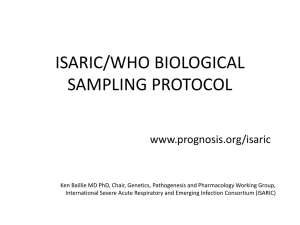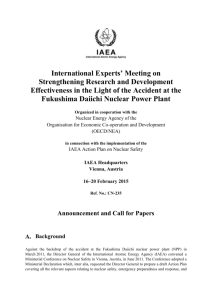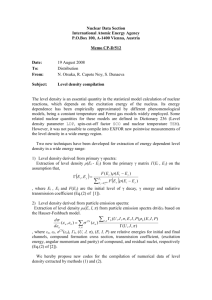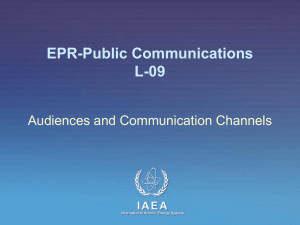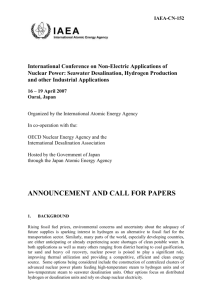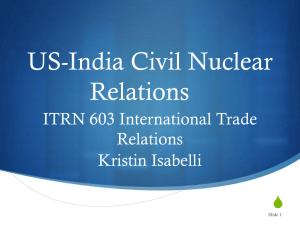Word - IAEA Publications - International Atomic Energy Agency
advertisement
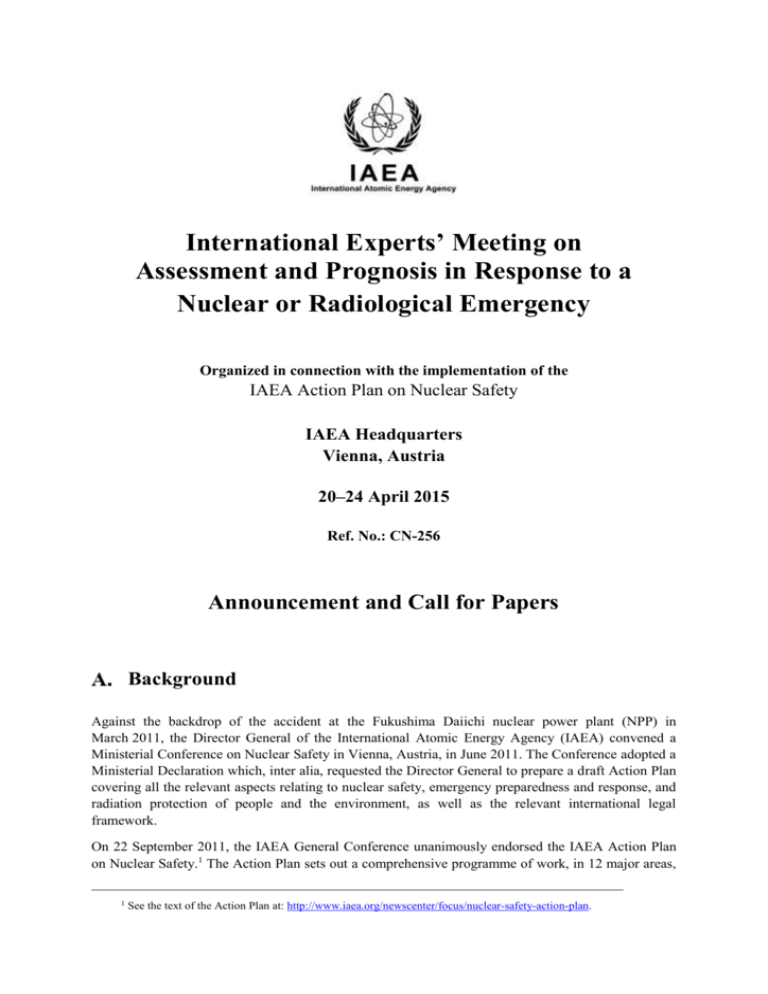
International Experts’ Meeting on Assessment and Prognosis in Response to a Nuclear or Radiological Emergency Organized in connection with the implementation of the IAEA Action Plan on Nuclear Safety IAEA Headquarters Vienna, Austria 20–24 April 2015 Ref. No.: CN-256 Announcement and Call for Papers Background Against the backdrop of the accident at the Fukushima Daiichi nuclear power plant (NPP) in March 2011, the Director General of the International Atomic Energy Agency (IAEA) convened a Ministerial Conference on Nuclear Safety in Vienna, Austria, in June 2011. The Conference adopted a Ministerial Declaration which, inter alia, requested the Director General to prepare a draft Action Plan covering all the relevant aspects relating to nuclear safety, emergency preparedness and response, and radiation protection of people and the environment, as well as the relevant international legal framework. On 22 September 2011, the IAEA General Conference unanimously endorsed the IAEA Action Plan on Nuclear Safety.1 The Action Plan sets out a comprehensive programme of work, in 12 major areas, ___________________________________________________________________________ 1 See the text of the Action Plan at: http://www.iaea.org/newscenter/focus/nuclear-safety-action-plan. Page 2 to strengthen nuclear safety worldwide. One area under the Action Plan, headed “Communication and information dissemination”, focuses on enhancing the transparency and effectiveness of communication as well as improving the dissemination of information. In this connection, the Action Plan calls upon the IAEA Secretariat to organize international experts’ meetings (IEMs) to analyse all relevant technical aspects and learn the lessons from the Fukushima Daiichi accident. This IEM, which is the ninth such meeting since the first IEM in March 2012, is being organized in support of this call and in response to the request of the General Conference resolution GC(58)/RES/10, which requested the Secretariat “…to continue organizing international experts’ meetings on lessons learned from the Fukushima Daiichi accident, including to address the issue of accident analysis and prognosis with the focus on possible gaps”. The 2011 IAEA Action Plan on Nuclear Safety expanded the IAEA Secretariat’s response role in an emergency at an NPP to cover the need “… to provide Member States, international organizations and the general public with timely, clear, factually correct, objective and easily understandable information during a nuclear emergency on its potential consequences, including analysis of available information and prognosis of possible scenarios based on evidence, scientific knowledge and the capabilities of Member States”. The IAEA General Conference, in its resolutions GC(57)/RES/9 and GC(58)/RES/10, further clarified that the IAEA Secretariat’s response role in such a context would cover all nuclear and radiological emergencies. In the light of the IAEA Action Plan on Nuclear Safety and the above-mentioned General Conference resolutions, many activities in relation to this expanded response role have been undertaken by the Secretariat in close collaboration with the Member States. The present IEM is being organized to facilitate the exchange of information on these activities and to discuss the way forward in the development of the assessment and prognosis process. Objectives The overall objective of this IEM is to provide a forum for experts from Member States and international organizations to discuss issues, challenges and solutions related to the assessment and prognosis process in response to a nuclear or radiological emergency. This includes the objectives of the process, its constraints, limitations and associated uncertainties. The meeting will focus on the exchange of information, knowledge and experience related to national and international assessment and prognosis capabilities, as well as to the operational arrangements for the implementation of the IAEA’s assessment and prognosis process. The meeting will be of interest to experts representing decision-makers, regulatory bodies, operators, competent authorities under the Convention on Early Notification of a Nuclear Accident and the Convention on Assistance in the Case of a Nuclear Accident or Radiological Emergency, technical support organizations (TSOs) and international organizations. The specific objectives of this IEM are to: • Share national experience in assessment and prognosis; • Discuss constraints, limitations and uncertainties associated with assessment and prognosis; • Discuss the implications of assessment and prognosis on determining public protective actions and communication strategies; Page 3 • Share the progress made in the operational implementation of the IAEA’s assessment and prognosis process in close cooperation with Member States; • Identify and discuss areas where existing assessment and prognosis tools and capabilities need to be strengthened; and • Discuss future prospects in the development of tools and capabilities for assessment and prognosis and for the implementation of assessment and prognosis at the international level. Topics The participants will share information on the state-of-the-art assessment and prognosis tools and capabilities, including their constraints and limitations, as well as on their respective countries’ national approaches to assessment and prognosis. Specifically, the IEM will address the following topics: Topic 1: Assessment and prognosis during a nuclear emergency o National approaches to assessment and prognosis o Accident progression and critical issues during reactor accidents o Development and improvement of analysis tools for use during severe accidents o Methodologies to support the prognosis of a developing situation and challenges in applying these o The effective use of probabilistic safety assessment information during the response phase o Assessment and prognosis of spent fuel pool accidents o Tools for source term calculation o Constraints and limitations of tools and capabilities used in assessment and prognosis, and uncertainties in the results o Current gaps and need for future development of assessment and prognosis tools and capabilities Topic 2: Assessment and prognosis during a radiological emergency o National approaches to assessment and prognosis in radiological emergencies (e.g. involving radiography sources, fuel fabrication facilities, uranium mines, waste storage sites, isotope production, transport, medical applications, etc.) o Tools for assessment and prognosis in radiological emergencies o Tools for assessment and prognosis of doses to workers and the public during a reactor accident o Monitoring and sampling strategies to assess doses to workers and the public o Constraints and limitations of tools and capabilities used in assessment and prognosis, and uncertainties in the results o Current gaps and need for future development of assessment and prognosis tools and capabilities Page 4 Topic 3: Assessment of a nuclear or radiological emergency resulting from a nuclear security event o Arrangements to ensure the continued effectiveness of the physical protection system during a nuclear or radiological emergency resulting from a nuclear security event o The potential influence of nuclear security on assessment and prognosis, including on the delivery and sharing of information o Public communication and media handling at the national and international levels o Nuclear forensics as a means to categorize nuclear and other radioactive materials as part of the response and as a means to protect the integrity of associated evidence Topic 4: Environmental modelling and monitoring during nuclear and radiological emergencies o Strategies for monitoring and sampling of radioactive substances in the environment o Tools for the assessment and prognosis of airborne releases during a response to an emergency o Tools for the assessment and prognosis of marine releases during a response to an emergency o Estimating the impact on marine biota o Issues unique to the marine environment o Constraints and limitations of tools and capabilities used in assessment and prognosis, and uncertainties in the results o Current gaps and need for future development of assessment and prognosis tools and capabilities Topic 5: Assessment of the impact of a nuclear or radiological emergency on food, feed, drinking water and agricultural products o National approaches to assessment and prognosis o Monitoring and sampling of food, feed, drinking water and milk o Monitoring and sampling of other agricultural products o Estimating the potential impact on the public food and drinking water supply o Constraints and limitations of tools and capabilities used in assessment and prognosis, and uncertainties in the results o Current gaps and need for future development of assessment and prognosis tools and capabilities Topic 6: Assessment and prognosis at the international level o The role of the IAEA in assessment and prognosis and its operational implementation o Role of other international organizations in assessment and prognosis o Constraints and limitations of the international assessment and prognosis process o National inputs into international assessment and prognosis Page 5 Topic 7: The provision and management of technical data to support assessment or prognosis o Methods for the management of critical technical information that needs to be shared o Challenges and solutions in post-accident monitoring o Technical data ownership and methods to address the handling of commercial proprietary information o Challenges in the provision, management and timely sharing of data Format The IEM will be held at the IAEA’s Headquarters in Vienna, Austria, from 20 to 24 April 2015. An opening address will be delivered by a senior IAEA representative. The meeting will consist of an opening plenary session, topic-specific technical sessions, some of which are to be run in parallel, panel discussions, poster presentations and a closing plenary session. The opening plenary session will include keynote presentations by invited international experts. Presentations will be given by experts from the IAEA Member States, the IAEA Secretariat and other international organizations. Summaries of the presentations and discussions, including observations and recommendations for further activities, will be prepared by the Chairperson(s) of the IEM and the Co-Chairpersons of each session and will be presented at the closing plenary session. An annotated programme will be made available on the IEM web page (see Section L below) in due course. Submission and Acceptance of Synopses Extended synopses on issues falling within the topics outlined in Section C may be submitted as contributions to the IEM. All contributed synopses must present original work and should not have been published elsewhere. There will be sessions at the IEM for those who have contributed a synopsis to give an oral and/or poster presentation of their work. A small number of poster presentations may also be selected for oral presentation. E.1. Submission of Synopses Experts from Member States who wish to give a presentation at the IEM must submit an extended synopsis (in English) of maximum 800 words (i.e. two A4 format pages of single spaced typing, or the equivalent, including any tables or diagrams and a few pertinent references) to be sent electronically to the general email address of the IEM Secretariat: IEM9@iaea.org. The synopses and the associated documents (see Sub-Section E.2. below) must be received by the IAEA by 15 February 2015. The synopsis should give enough information on the contents of the proposed paper to enable the Technical Programme Committee to evaluate it. Introductory and general matters should not be included. The synopsis — if accepted — will be reproduced in the Book of Extended Synopses. Page 6 Authors are urged to make use of the Synopsis Template in Word format that will be made available on the IEM web page (see Section L below). E.2. Acceptance of Synopses An extended synopsis will be considered only if the Participation Form (Form A) and Form for Submission of a Paper (Form B) have been received by the indicated deadline and through the appropriate official channels. Authors will be informed by the end of February 2015 as to whether their synopses have been accepted by the Technical Programme Committee. Guidelines for the preparation of presentations and posters will be provided at that time. Advance copies of presentations/posters have to be submitted by 15 April 2015. Given the need to provide ample time for discussion, the number of presentations that can be accepted is limited. If the number of relevant and high quality synopses that are considered worthy of selection exceeds the acceptable number, some of them may be selected for poster presentation instead. The IEM Secretariat reserves the right to exclude synopses that do not comply with the IAEA’s quality standards and/or do not apply to one of the topics listed in Section C. The proceedings of the IEM will be made available online to Member States through the IAEA Action Plan on Nuclear Safety dashboard: http://www-ns.iaea.org/actionplan/default.asp The proceedings will include the Chairpersons’ summaries, the presentations, the outcomes of panel discussions and recommendations. Participation The IEM is targeted primarily at experts from Member States working at institutes that are involved in emergency preparedness and response as well as assessment and prognosis during nuclear incidents or emergencies, and/or that are involved in the design and research work to support the development of assessment and prognosis capabilities for nuclear power reactors. This includes experts from operating organizations, regulatory bodies and TSOs. All experts designated by Member States to participate in the meeting are requested to register online in advance through the IEM web page (see Section L). In addition, they are required to send a completed Participation Form (Form A) and, if applicable, the Form for Submission of a Paper (Form B) and the Grant Application Form (Form C) to the competent national authority (e.g. the Ministry of Foreign Affairs or National Atomic Energy Authority) for subsequent transmission to the IAEA by email to: Official.Mail@iaea.org. Participants will be accepted only if the Participation Form is transmitted through the competent national authority of a Member State of the IAEA or by an invited organization. Participants whose official designations have been received by the IAEA will receive further information on the IEM approximately two months before the beginning of the meeting. This information will also be posted on the IEM web page. Page 7 Expenditures No registration fee is charged to participants. The IAEA is generally not in a position to bear the travel and other costs of participants in the IEM. The IAEA has, however, limited funds at its disposal to help meet the cost of attendance of certain participants. Such assistance may be offered upon specific request to normally one participant per country provided that, in the IAEA’s view, the participant on whose behalf assistance is requested will make an important contribution to the IEM. If governments wish to apply for a grant on behalf of one of their experts, they should address specific requests to the IAEA to this effect. Governments should ensure that applications for grants are submitted by 15 February 2015 and that they are accompanied by a duly completed and signed Grant Application Form (Form C). Approved grants will be issued in the form of a lump sum payment that usually covers only part of the cost of attendance. Key Deadlines Submission of extended synopsis together with Forms A and B 15 February 2015 Submission of Grant Application Form (Form C), if applicable 15 February 2015 Submission of advance copy of presentation/poster 15 April 2015 Working Language The working language of the IEM will be English. All communications, synopses and documentations must be sent to the IAEA in English. Visas Designated participants who require a visa to enter Austria should submit the necessary application to the nearest diplomatic or consular representative of Austria at least four weeks before they travel to Austria. Since Austria is a Schengen State, persons requiring a visa will have to apply for a Schengen visa. In States where Austria has no diplomatic mission, visas can be obtained from the consular authority of a Schengen Partner State representing Austria in the country in question. Page 8 IEM Secretariat General contact details of the IEM Secretariat: Ref.: CN-256 International Atomic Energy Agency (IAEA) Vienna International Centre PO Box 100 1400 VIENNA AUSTRIA Tel.: +43 1 2600 Fax: +43 1 26007 Email: Official.Mail@iaea.org IAEA Scientific Secretary: Ms Elena Buglova Incident and Emergency Centre Department of Nuclear Safety and Security Tel.: +43 1 2600 22738 Fax: + 43 1 26007 22738 Email: IEM9@iaea.org Administration and organization: Ms Martina Neuhold Conference Services Section Division of Conference and Document Services Department of Management Tel.: +43 1 2600 21314 Fax: +43 1 26007 Email: IEM9@iaea.org Subsequent correspondence on scientific matters should be sent to the Scientific Secretary and correspondence on administrative matters to the IAEA’s Conference Services Section — in both cases by email to: IEM9@iaea.org. IEM Web Page Please visit the IEM web page regularly for new information regarding the meeting: http://www-pub.iaea.org/iaeameetings/50718/IEM-9


